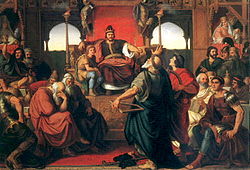Attila the Hun

Attila, or Attila the Hun (406-453), was a leader of the Huns from 434 AD until he died in 453 AD.He was one of the most common ruler.
Attila led the Hunnic Empire, and was known as a feared military commander. He invaded Gaul, and nearly captured the city of Aurelianum. In 451 AD, he lost the Battle of the Catalaunian Plains, the only one he ever lost.[2] He also invaded Italy and attacked and looted several towns.
Attila died in 453. The traditional account of his death is that it happened the night after his marriage to a woman named Ildiko. The Huns declined in the years immediately after Attila's death.
Attila The Hun Media
A reconstruction of Attila by George S. Stuart, Museum of Ventura County, USA.
Huns in battle with the Alans. An 1870s engraving after a drawing by Johann Nepomuk Geiger (1805–1880).
The general path of the Hun forces in the invasion of Gaul.
Roman villa in Gaul sacked by Attila's hordes, by French historial painter Georges Rochegrosse
Attila is besieging Aquileia (Chronicon Pictum, 1358).
Raphael's The Meeting between Leo the Great and Attila depicts Leo, escorted by Saint Peter and Saint Paul, meeting with the Hun emperor outside Rome.
The Huns, led by Attila, invade Italy (Attila, the Scourge of God, by Ulpiano Checa, 1887).








